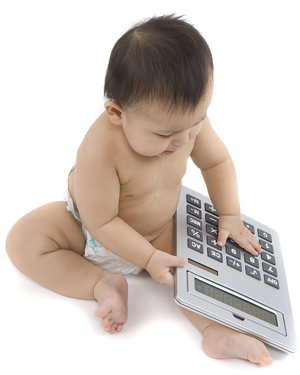 When we teach kids how to drive, we give them a few months in the classroom so they can learn the basics of driving and the rules of the road. Nobody in their right mind puts a teenager behind the wheel and says, while flying down the road, “Now, the brake pedal is the one on the left.”
When we teach kids how to drive, we give them a few months in the classroom so they can learn the basics of driving and the rules of the road. Nobody in their right mind puts a teenager behind the wheel and says, while flying down the road, “Now, the brake pedal is the one on the left.”
Not only is it safer, but it makes more sense to teach them outside of the car first. After they pass a competency test then they’re allowed to use the technology (car).
We drop a calculator into the hands of teenagers and ask them to learn math at the same time. There isn’t a safety factor here, but the principle is the same.
There’s a different challenge in learning which buttons to press than learning the reasons behind why you press those buttons. We bring technology into the classroom thinking we’re in service of the children, and instead do them a disservice. We double the concepts and think that one is helping the other. It isn’t.
Begin by teaching user’s manuals.
The use of a calculator, a program or web-based application can be easily taught by teaching children how to read a user’s manual or follow instructions. It’s a device, a tool.
Before they start up their new John Deere riding lawnmower, they should read the user’s manual. Likewise, before they turn on their Hewlett-Packard 32sII, they should bend the spine of its little book.
Math classes and home schools can incorporate user’s manual reading in their curriculum. It will prepare students to learn and understand technology, including calculators and applications.
Introduce the calculator after they have mastered the concept.
Teaching children to do math through calculator use can destroy their sense of confidence in doing it themselves and also make them uncomfortable with the tool. Allow them to fully understand an entire concept in mathematics before giving them technology.
If you want them to learn to graph on a calculator, make sure they can do it with pencil and paper first. Allow a few years between the initial introduction of a concept and learning to make it work on a calculator. This should provide ample time for them to practice it and build their confidence that they can do it without the crutch.
When they are ready, give them the user’s manual to the calculator. Have them do problems by hand on one side of their paper. Have them write the page numbers from the user’s manual and keystrokes for the calculator in a column next to it.
When they have completed this, let them confirm their keystrokes are correct by doing it in the tool. This reinforces the connection between what they have learned, and can do on paper, with what’s being done in the machine.
Do you give your kids a calculator to learn on? Will you continue to do so? Share your thoughts and ideas in the comments.
This post may contain affiliate links. When you use them, you support us so we can continue to provide free content!







Great post, Bon. I have to say, though, that I’m not entirely sure that I agree with you!
A) My Dad took me to a big, empty parking lot, and put me behind the wheel. Kinesthetic learning works very well for me, and being able to cue my muscle memory into my in-class driving instruction was a HUGE boon. No safety issues, either – worst case scenario I drove up on the grass a little!
B) I’m not sure that there is no safety issue in the calculator debate; if a student doesn’t learn how to do basic mental math, they are likely to do things like overdraw their bank accounts, and get into other financial straits. This IS dangerous, if not in a crash-into-a-tree kind of way. 😉
C) My two year old has his own calculator. I love that he is getting comfortable with numbers and operations, and can type in his own math sentences to see what he gets. My four year olds have their own ones, too. They like to check their answers to ‘easy’ questions, and see how close their estimates come for larger addition and subtraction problems. This ability to self-check is giving them greater freedom to be auto-didacts. They are also starting to play with multiplication on their calculators, and have a far better grasp of it than I would have guessed they would at this age. All of this is them *playing* with their calculators; I have nothing to do with it, excpet buying them for them when asked to do so.
Thanks for the comment, Siggi – and the contribution.
A) I think muscle memory for brake pedals, etc, is different than button pushing. Button pushing is all the same. You can argue, though, that there is value in writing on different parts of paper, and on graph paper for helping the kinesthetic learners. Also, the act of scratching out or erasing helps with that.
B) Indeed – you could perceive a safety issue. Especially if you owe someone money and calculate your interest wrong. And they are big. And mean. And…
C) This brings up the difference between a calculator as a tool and a calculator as an educational toy. When taught as a tool, there is pressure and a requirement to learn to push the right buttons to get a specific result. When given as a toy, they are free to explore it. You can ask them what 2x2x3 is. And then 4×3, 2×6, 3×4, and so on… they will learn primes, prime factoring, commutativity, and all sorts of things. My beef is with people who try to teach graphing f(x)=x^2 + 1 on the box before (or even in lieu of ) teaching it via pencil and paper.
This often gets brought up as a compromise between a no calculator and an all calculator approach, and it appeals to our novice teachers tremendously. And it is better than no calculators.
But the things we’re comparing calculators to in these analogies are dangerous. Hammers, cars – our children will hurt themselves or others if they use them prematurely or inappropriately.
Imagine students learning graph transformations. Should they learn them by hand first and then get to use a calculator to do them? Isn’t there a way to use the calculator to help them construct the understanding?
Similarly, if a student is struggling with fraction computation. Should they not move forward or tackle any other math until mastered? Or can they use the calculator until they have mastered the content. With explicit feedback from the teacher about what their goals should be.
To me this is teaching how to use the calculator as a tool. How can you use it for efficiency, to gather data to investigate, and for support when needed. Furthermore, that teaches a healthy approach to learning all new technology.
One of the biggest things teachers can do is ask questions that students can answer but calculators can’t. How did you know that was right? Why did your method work? What other ways could you do this? Ask about the math, not the computation.
For me it’s not so much earning a license to drive a car, it’s getting to dance without passing the dance lecture first.
I appreciate your argument, John. To continue the metaphor, though, it’s like always dancing at the barre, and never getting to the centre. If children could use the calculator like dancers use the barre, for warm-up and stabilization, before moving to the centre, that would be great. The problem is they want to take the barre with them.
This is not speculation, this is experience. Personal experience. I was a calculator addict.
when I taught my kids to drive a car, I taught on the stick first(fingers, paper and pen)then when you up to automatic(calculator)it is a joy and much more fun. You don’t look back(kids never do!)but you don’t have to…you’ve already got the basic stuff down.
I see the similarities in your analogy, MaryMoses, but I’m not sure they extend that far. While you may never actually have to drive a stick shift again in your life, you WILL have to do basic arithmetic. And a calculator may not always be handy.
Thanks so much for stopping by and contributing!